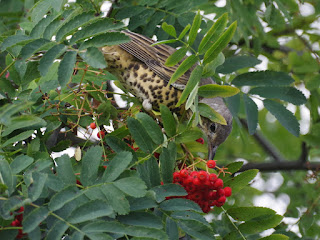This is puzzling. I thought there were two pairs of grebes on the Long Water, one of which had chicks some time ago, of which at least one survives and is now quite large, and the other nesting under the willow treee by the bridge, whose nest no longer had eggs in it yesterday. It's tempting to assume that the pair in this picture are the ones I photographed yesterday under the willow looking at the empty nest. But there is no sign of chicks in that picture, or in any other pictures I took then.
Ignoring the protest of a teenage Coot ...
... a Greylag Goose picked insects out of the nest at the Dell restaurant. After it had gone away, one of the adults crossly repaired the damage.
The Coots which have been trying to nest at the Serpentine outflow seem to have given up at last, after five attempts. A Moorhen has taken over the abandoned nest. It is not as good at arranging bits of plastic bag as the Coots were.
An old plastic bag encrusted with algae provided a meal for the Coot chicks on the Long Water.
Two Mandarins appeared at the Vista, not the pair I saw recently as both of them are female.
The comings and goings of Mandarins are mysterious because (like the equally mysterious Red-Crested Pochards) their main population is outside the park and they visit the Long Water at random.
The Pochard rested with her ducklings, now large teenagers, on a fallen branch on the far side of the Long Water.
The usual five teenage Mallards cruised briskly across by Peter Pan, followed by their mother.
There was a Mallard with three ducklings on the Serpentine near the bridge. New broods keep appearing here, but predation by Herring Gulls is severe.
A Grey Heron stood on one of the floating baskets at the island.
The original water plants in these died many years ago. There is now some purple loosestrife, which grows well in wet conditions, and some willowherb (both Rose Bay and Great) which is not doing nearly as well and is yellow and sickly looking. It would be good to find some hardy plants that will resist being torn up by Coots to improve the appareance of these tatty wire baskets. I've neen talking with Hugh, the Wildlife Officer, about this.
A view of the Little Owl near the Albert Memorial on one of his favourite branches.
A Blue Tit demolished the web spun by some larva to protect itself while it pupated.
There was a Mistle Thrush in the rowan trees on Buck Hill, the first I've seen there this year. The berries have appeared very early this year. I don't think the bird is a migrant -- we have a few year-round resident Mistle Thrushes.
The grass on Buck Hill is partly mown short and partly left to grow long. Grasshoppers abound in the long grass, but it's hard for birds to move around in it, so they patrol the edge looking in to see what they can grab. Not only Magpies but Carrion Crows, Mistle Thrushes and Kestrels all behave in this way.
Carp are particularly fond of peanuts. The normally placid fish in the Italian Garden fountains become quite animated when some are thrown into the water.
Casting practice on Buck Hill: trying to drop the line on to the yellow target at the left.
A Buff-Tailed Bumblebee worked its way over a teasel at the esst end of the Lido. There are quite a lot of teasels here now, and later in the year the seed heads should attract Goldfinches.












I'm astonished: it never occured to me that any fish could, or would eat nuts. (yes I know a peanut isn't actually a nut). Still. Learn something new every day.
ReplyDeleteIt's hard to imagine how they got a taste for this non-native thing.
DeleteThe severe Herring Gull predation may have spread to Golders Hill Park, where it has long been dire for Mallard ducklings with vindictive pond-mates and nocturnal foxes. I saw a Herring Gull attempt a snatch there a week ago, a personal first. It was repelled by the mother and retreated to worm-dance, but it had been loitering around the pond for some time and I wondered if it was hoping for another Larus to show up for teamwork. The three ducklings had vanished two days later. Jim
ReplyDeleteI suppose that Herring Gulls will always snatch chicks when they get the chance. It's the number of these gulls in London that's changed. As they decline elsewhere they have become urban birds.
DeleteThat's not good news for the rest of the birds. It's the same thing with magpies: they have been pushed to find a living in the cities, and they wreak havoc with the small birds.
DeleteMoorhens are dimidiatae fulicae, halved coots (recalling the anecdote about Caesar, who reportedly called Terentius "dimidiatus Menander",a halved Menander).
Reminded, irrelevantly, of Semigallia, an ancient province in what is now Latvia. Semigallia omnis in sesquiunas partes divisa est.
Delete